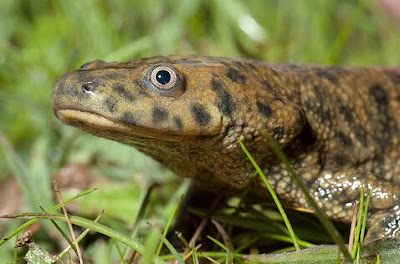While perhaps not as hardy as the highly adaptable killifish, some of the most interesting experiments in space have involved fresh water amphibians.
While periods of weightlessness are known to decrease bone, the amazing power of newts to regenerate lost limbs actually increases in micro-gravity! Isn't that fascinating? When a portion of a leg or tail is lost, they replace the structural cells far more quickly than they normally would on Earth. What would make one system increase productivity and another decrease?
Other absorbing studies have revolved around gravitoreceptors of frogs' vestibular apparatus. In English, that means we watched them get space sick along with the astronauts. Did you know you have otoliths in your inner ear that contribute to your body balance? Your friendly neighborhood frog's are nearly identical to yours, and studying his in space makes it easier for scientists to see how yours react.

Iberian Ribbed Newt
The Russians were the first to experiment with newts inside their Bion 7 Soviet Cosmos satellite in 1985. The Iberian ribbed newts, members of a Salamander sub-family, had portions of their limbs deliberately removed, to see if they retained regenerative powers; surprisingly, some developed their limbs again at nearly twice the speed!
Varied species were taken aboard the subsequent Bions 10 and 11, as well as the Mir Space Station, all in the 1990s; red-bellied news traveled on Space Shuttle Columbia in 1994, as well as ESA's Foton-M2 in 2005. They were also the first animals ever launched by Japan's space agency, inside the 1995 Space Flyer Unit.
That's an awful lot of under-appreciated orbiting newts! In each case, they were good "model organisms" for the study of microgravity, and have been tested in various stages of larval or adult development, for hormonal patterns and any abnormalities in reproductive activity. Happily, baby newts born in space adapt just fine to Earth gravity upon return.

In 1970, NASA conducted the OFO Experiment, or the "Orbiting Frog Otolith." Sounds like a punk rock band, doesn't it. (The name has even influenced a modern blog, Orbiting Frog, which is rather a fun science read.)
Two bullfrogs were launched into orbit so scientists could determine through neurophysiological tests how their otoliths reacted to weightlessness, lending clues to how vestibular organs function. Would they adapt? Once adapted, could they return to Earth and re-adapt to gravity?
The frogs were initially intended to be part of the early Apollo program, but later re-directed into a biology satellite that housed one of the more unique specimen containers. Good thing too. Given Shepard's antics with golf bolls, I cannot even imagine what Beavis-and-Buttheadian adventures we would have gotten up to with frogs on the moon.
These weren't the first frogs in space, just the most humorously named. Like most space firsts, the title goes to the Russians, for flying Japanese Tree frogs in Vostok 3A in 1961. Another acronym accompanied six tree hoppers: the "Frogs in Space" (FRIS) aboard Mir, carried there by the first Japanese astronaut in 1990.
In these experiments, frogs floated freely about the station, and specialists noticed they took up a "parachuting" posture when drifting. I browsed around trying to find some video of this, but only happened across one disturbing video of a frantic frog kicking like crazy. Didn't look too tranquil to me, I say we keep the amphibs in the water...!


































































